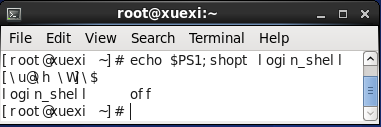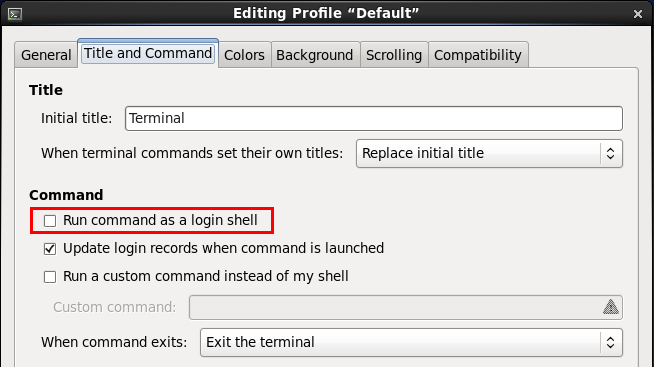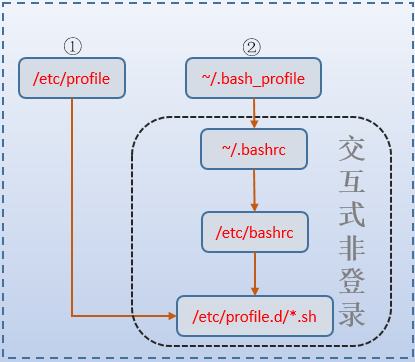bash&shell系列文章:http://www.cnblogs.com/f-ck-need-u/p/7048359.html
当用户登录系统时,会加载各种bash配置文件,还会设置或清空一系列变量,有时还会执行一些自定义的命令。这些行为都算是启动bash时的过程。
另外,有些时候登录系统是可以交互的(如正常登录系统),有些时候是无交互的(如执行一个脚本),因此总的来说bash启动类型可分为交互式shell和非交互式shell。更细分一层,交互式shell还分为交互式的登录shell和交互式非登录shell,非交互的shell在某些时候可以在bash命令后带上"--login"或短选项"-l",这时也算是登录式,即非交互的登录式shell。
1.1 判断是否交互式、是否登录式
判断是否为交互式shell有两种简单的方法:
方法一:判断变量"-",如果值中含有字母"i",表示交互式。
[root@xuexi ~]# echo $- himBH [root@xuexi ~]# vim a.sh #!/bin/bash echo $- [root@xuexi ~]# bash a.sh hB
方法二:判断变量PS1,如果值非空,则为交互式,否则为非交互式,因为非交互式会清空该变量。
[root@xuexi ~]# echo $PS1 [u@h W]$
判断是否为登录式的方法也很简单,只需执行"shopt login_shell"即可。值为"on"表示为登录式,否则为非登录式。
[root@xuexi ~]# shopt login_shell
login_shell on
[root@xuexi ~]# bash [root@xuexi ~]# shopt login_shell login_shell off
所以,要判断是交互式以及登录式的情况,可简单使用如下命令:
echo $PS1;shopt login_shell
# 或者
echo $-;shopt login_shell
1.2 几种常见的bash启动方式
(1).正常登录(伪终端登录如ssh登录,或虚拟终端登录)时,为交互式登录shell。
[root@xuexi ~]# echo $PS1;shopt login_shell [u@h W]$ login_shell on
(2).su命令,不带"--login"时为交互式、非登录式shell,带有"--login"时,为交互式、登录式shell。
[root@xuexi ~]# su root [root@xuexi ~]# echo $PS1;shopt login_shell [u@h W]$ login_shell off
[root@xuexi ~]# su - Last login: Sat Aug 19 13:24:11 CST 2017 on pts/0 [root@xuexi ~]# echo $PS1;shopt login_shell [u@h W]$ login_shell on
(3).执行不带"--login"选项的bash命令时为交互式、非登录式shell。但指定"--login"时,为交互式、登录式shell。
[root@xuexi ~]# bash [root@xuexi ~]# echo $PS1;shopt login_shell [u@h W]$ login_shell off
[root@xuexi ~]# bash -l [root@xuexi ~]# echo $PS1;shopt login_shell [u@h W]$ login_shell on
(4).使用命令组合(使用括号包围命令列表)以及命令替换进入子shell时,继承父shell的交互和登录属性。
[root@xuexi ~]# (echo $BASH_SUBSHELL;echo $PS1;shopt login_shell) 1 [u@h W]$ login_shell on
[root@xuexi ~]# su [root@xuexi ~]# (echo $BASH_SUBSHELL;echo $PS1;shopt login_shell) 1 [u@h W]$ login_shell off
(5).ssh执行远程命令,但不登录时,为非交互、非登录式。
[root@xuexi ~]# ssh localhost 'echo $PS1;shopt login_shell' login_shell off
(6).执行shell脚本时,为非交互、非登录式shell。但指定了"--login"时,将为非交互、登录式shell。
例如,脚本内容如下:
[root@xuexi ~]# vim b.sh #!/bin/bash echo $PS1 shopt login_shell
不带"--login"选项时,为非交互、非登录式shell。
[root@xuexi ~]# bash b.sh login_shell off
带"--login"选项时,为非交互、登录式shell。
[root@xuexi ~]# bash -l b.sh login_shell on
(7).在图形界面下打开终端时,为交互式、非登录式shell。

但可以设置为使用交互式、登录式shell。

1.3 加载bash环境配置文件
无论是否交互、是否登录,bash总要配置其运行环境。bash环境配置主要通过加载bash环境配置文件来完成。但是否交互、是否登录将会影响加载哪些配置文件,除了交互、登录属性,有些特殊的属性也会影响读取配置文件的方法。
bash环境配置文件主要有/etc/profile、~/.bash_profile、~/.bashrc、/etc/bashrc和/etc/profile.d/*.sh,为了测试各种情形读取哪些配置文件,先分别向这几个配置文件中写入几个echo语句,用以判断该配置文件是否在启动bash时被读取加载了。
echo "echo '/etc/profile goes'" >>/etc/profile
echo "echo '~/.bash_profile goes'" >>~/.bash_profile
echo "echo '~/.bashrc goes'" >>~/.bashrc
echo "echo '/etc/bashrc goes'" >>/etc/bashrc
echo "echo '/etc/profile.d/test.sh goes'" >>/etc/profile.d/test.sh
chmod +x /etc/profile.d/test.sh
①.交互式登录shell或非交互式但带有"--login"(或短选项"-l",例如在shell脚本中指定"#!/bin/bash -l"时)的bash启动时,将先读取/etc/profile,再依次搜索~/.bash_profile、~/.bash_login和~/.profile,并仅加载第一个搜索到且可读的文件。当退出时,将执行~/.bash_logout中的命令。
但要注意,在/etc/profile中有一条加载 /etc/profile.d/*.sh 的语句,它会使用source加载/etc/profile.d/下所有可执行的sh后缀的脚本。
[root@xuexi ~]# grep -A 8 *.sh /etc/profile for i in /etc/profile.d/*.sh ; do if [ -r "$i" ]; then if [ "${-#*i}" != "$-" ]; then . "$i" else . "$i" >/dev/null 2>&1 fi fi done
内层if语句中的 "${-#*i}" != "$-" 表示将"$-"从左向右模式匹配"*i"并将匹配到的内容删除(即进行变量切分),如果"$-"切分后的值不等于"$-",则意味着是交互式shell,于是怎样怎样,否则怎样怎样。
同样的,在~/.bash_profile中也一样有加载~/.bashrc的命令。
[root@xuexi ~]# grep -A 1 ~/.bashrc ~/.bash_profile if [ -f ~/.bashrc ]; then . ~/.bashrc fi
而~/.bashrc中又有加载/etc/bashrc的命令。
[root@xuexi ~]# grep -A 1 /etc/bashrc ~/.bashrc if [ -f /etc/bashrc ]; then . /etc/bashrc fi
其实/etc/bashrc中还有加载 /etc/profile.d/*.sh 的语句,但前提是非登录式shell时才会执行。以下是部分语句:
if ! shopt -q login_shell ; then # We're not a login shell
...
for i in /etc/profile.d/*.sh; do
if [ -r "$i" ]; then
if [ "$PS1" ]; then
. "$i"
else
. "$i" >/dev/null 2>&1
fi
fi
done
...
fi
从内层if语句和/etc/profile中对应的判断语句的作用是一致的,只不过判断方式不同,写法不同。
因此,交互式的登录shell加载bash环境配置文件的实际过程如下图:

以下结果验证了结论:
Last login: Mon Aug 14 04:49:29 2017 # 新开终端登录时
/etc/profile.d/*.sh goes
/etc/profile goes
/etc/bashrc goes
~/.bashrc goes
~/.bash_profile goes
[root@xuexi ~]# ssh localhost # ssh远程登录时 root@localhost's password: Last login: Mon Aug 14 05:05:50 2017 from 172.16.10.1 /etc/profile.d/*.sh goes /etc/profile goes /etc/bashrc goes ~/.bashrc goes ~/.bash_profile goes
[root@xuexi ~]# bash -l # 执行带有"--login"选项的login时 /etc/profile.d/*.sh goes /etc/profile goes /etc/bashrc goes ~/.bashrc goes ~/.bash_profile goes
[root@xuexi ~]# su - # su带上"--login"时 /etc/profile.d/*.sh goes /etc/profile goes /etc/bashrc goes ~/.bashrc goes ~/.bash_profile goes
[root@xuexi ~]# vim a.sh # 执行shell脚本时带有"--login"时 #!/bin/bash -l echo haha [root@xuexi ~]# ./a.sh /etc/profile goes /etc/bashrc goes ~/.bashrc goes ~/.bash_profile goes haha
之所以执行shell脚本时没有显示执行 /etc/profile.d/*.sh ,是因为它是非交互式的,根据/etc/profile中的 if [ "${-#*i}" != "$-" ] 判断,它将会把 /etc/profile.d/*.sh 的执行结果重定向到/dev/null中。也就是说,即使是shell脚本(带"--login "选项),它也加载了所有bash环境配置文件。
②.交互式非登录shell的bash启动时,将读取~/.bashrc,不会读取/etc/profile和~/.bash_profile、~/.bash_login和~/.profile。
因此,交互式非登录shell加载bash环境配置文件的实际过程为下图内方框中所示:

例如,执行不带"--login"的bash命令或su命令时。
[root@xuexi ~]# bash /etc/profile.d/*.sh goes /etc/bashrc goes ~/.bashrc goes
[root@xuexi ~]# su /etc/profile.d/*.sh goes /etc/bashrc goes ~/.bashrc goes
③.非交互式、非登录式shell启动bash时,不会加载前面所说的任何bash环境配置文件,但会搜索变量BASH_ENV,如果搜索到了,则加载其所指定的文件。但并非所有非交互式、非登录式shell启动时都会如此,见情况④。
它就像是这样的语句:
if [ -n "$BASH_ENV" ];then . "$BASH_ENV" fi
几乎执行所有的shell脚本都不会特意带上"--login"选项,因此shell脚本不会加载任何bash环境配置文件,除非手动配置了变量BASH_ENV。
④.远程shell方式启动的bash,它虽然属于非交互、非登录式,但会加载~/.bashrc,所以还会加载/etc/bashrc,由于是非登录式,所以最终还会加载/etc/profile.d/*.sh,只不过因为是非交互式而使得执行的结果全部重定向到了/dev/null中。
如果了解rsync,就知道它有一种远程shell连接方式。所谓的远程shell方式,是指通过网络的方式启动bash并将bash的标准输出关联起来,就像它连接了一个远程的shell守护进程一样。一般由sshd实现这样的连接方式,老版的rshd也一样支持。
事实也确实如此,使用ssh连接但不登录远程主机时(例如只为了执行远程命令),就是远程shell的方式,但它却是非交互、非登录式的shell。
[root@xuexi ~]# ssh localhost echo haha root@localhost's password: /etc/bashrc goes ~/.bashrc goes haha
正如上文所说,它同样加载了 /etc/profile.d/*.sh ,只不过/etc/bashrc中的if判断语句 if [ "$PS1" ]; then 使得非交互式的shell要将执行结果重定向到/dev/null中。